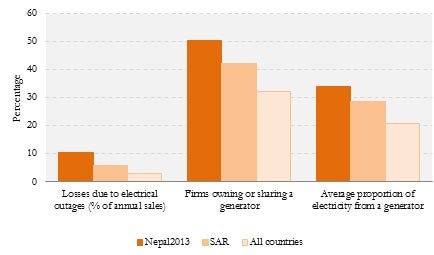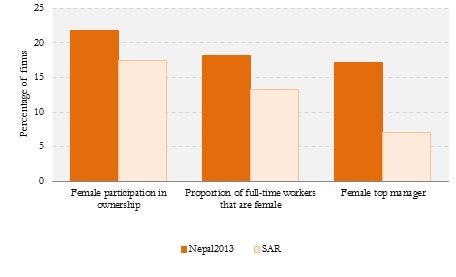One of the primary goals of the Enterprise Surveys is to provide high quality data about the business environment based on establishments’ actual day-to-day experiences. This provides much needed information given how little is known about what businesses experience in developing economies. To raise awareness of the recently released Nepal 2013 Enterprise Survey, we provide a few highlights below.
The Nepal 2013 Enterprise Survey consists of face-to-face interviews with 482 firms across the Central, Western, and Eastern regions in Nepal. Fieldwork was conducted between February and June 2013, with survey questions referencing the 2013 fiscal year. This post will focus on a couple of highlights. For the full survey highlights please see the Nepal 2013 Country Highlights document.
One of the biggest constraints faced by firms in Nepal is power outages and the losses firms experience from them. As seen in the figure below, firms in Nepal experience high losses due to electrical outages – almost 10% of sales – and thus many firms utilize generators. This is a far higher figure than that of firms in other South Asian countries as well as in all countries with Enterprise Surveys data.
Figure 1: Nepali firms are compensating for poor electricity infrastructure through generator usage.
Furthermore, apart from political instability, electricity is ranked second in terms of the biggest obstacle faced by the private sector as shown below.
Figure 2: Political instability and electricity are the two top ranked obstacles facing the private sector.
On a more positive note, female inclusion in economic activity in terms of labor force employment, participation in ownership, and managerial position is commendable. Proportionately more women participate as managers and as workers compared to other South Asian countries. More than 17 percent of firms in Nepal have a female top manager, which is more than twice the percentage of firms in the South Asia region, as indicated in the figure below:
Figure 3:
For more indicators please visit the Nepal 2013 economy snapshot in the Enterprise Surveys website. The raw survey data can also be obtained here after registration. Please feel free to provide comments, specifically for our Country Highlights.




Join the Conversation